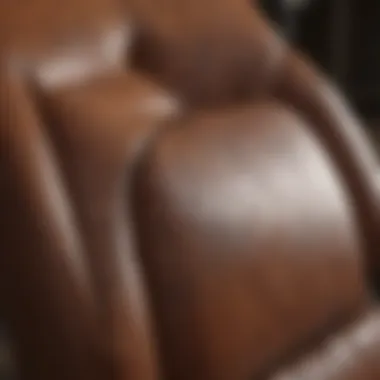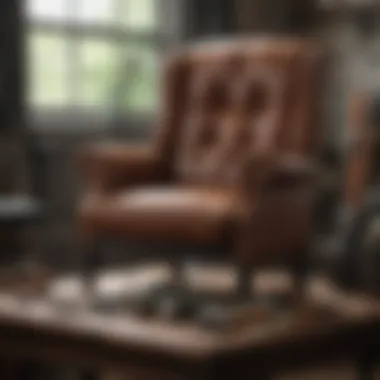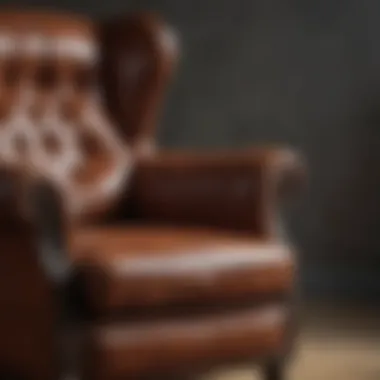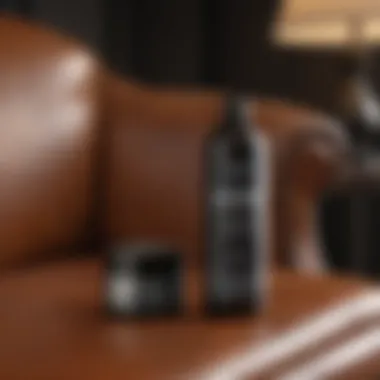Repairing Cracked Leather Chairs: A Comprehensive Guide


Intro
Leather chairs are often a blend of elegance and practicality. However, their beauty can be compromised with time as they might develop cracks. Factors like aging, exposure to sunlight, and lack of proper care can contribute to this deterioration. Understanding these factors is the first step in preserving the investment made in your leather furniture.
Addressing cracks in leather chairs not only enhances their appearance but also extends their lifespan. This guide will explore the reasons behind leather cracking, offer practical repair methods, and provide essential maintenance tips. Homeowners and design enthusiasts will find valuable insights, making it easier to keep their leather chairs in pristine condition.
Design Inspiration
Trending Styles
When repairing leather chairs, it may also be a great opportunity to consider design styles that align with your existing decor. Popular styles include modern minimalism, vintage chic, and rustic charm. Each style offers unique elements that can influence your repair choices. For instance, a minimalist approach may focus on subtle repairs that maintain a sleek look, while a vintage style might embrace the natural wear of leather, turning flaws into character.
Color Palettes
Color can play a significant role in the appeal of leather furniture. Popular palettes range from classic browns and blacks to bold colors like deep red or navy blue. When repairing, consider whether to restore the original color or experiment with a new hue. Using dyes specifically designed for leather can help achieve the desired effect while still protecting the material.
Practical Tips
Maintenance & Care
To prevent cracks from forming, regular maintenance is essential. Here are some tips on how to care for your leather:
- Clean regularly: Use a soft, damp cloth to remove dirt and dust. Avoid using harsh chemicals that may damage the leather.
- Condition the leather: Apply a high-quality leather conditioner every six months. This helps restore moisture and prevents drying.
- Avoid direct sunlight: Position chairs away from windows where UV rays could cause fading and cracking.
Budgeting & Planning
Before initiating repairs, it is crucial to budget accordingly. Repair methods can vary in cost depending on the extent of damage and whether you opt for professional help or DIY solutions. Here are some factors to consider:
- Extent of damage: Assess how many chairs need repairs and the type of damage.
- Material costs: If you choose a DIY approach, research the cost of leather repair kits, fillers, and conditioners.
- Professional vs. DIY: Determine if hiring a professional is necessary. Professionals might provide more polished results but can be more costly.
"Regular maintenance can significantly extend the life of your leather furniture, making it a wise investment."
Understanding these elements prepares you for the repair process and enhances the enjoyment of your leather chair. The right care will not only keep them looking good but will also contribute to a more enjoyable living space.
Understanding Leather Material
Understanding the material involved in leather furniture is fundamental to appreciating its qualities and addressing repairs effectively. Leather is more than just a surface finish; it is a complex natural material that combines beauty with practicality. By comprehending the different types of leather and their properties, one can make informed decisions about repairs and maintenance. This knowledge ultimately helps preserve the integrity and appearance of leather chairs, making it a worthwhile focus in this guide.
Types of Leather
Full-grain Leather
Full-grain leather represents the highest quality of leather available. It is made from the top layer of the hide, retaining its natural grain, which provides unique character and rich texture. This type of leather is known for its exceptional durability and flexibility.
The key characteristic of full-grain leather is its unaltered surface. Unlike other types that may be sanded or treated, this leather showcases the natural imperfections and marks, which add to its aesthetic appeal. Full-grain leather is a popular choice in luxury furniture, as it ages gracefully, developing a rich patina over time.
However, its porous nature means it requires discrete maintenance to prevent damage from spills and exposure to sunlight.
Top-grain Leather
Top-grain leather is slightly less robust than full-grain leather but remains among the top options for quality upholstery. It is also crafted from the upper layer of the hide, but undergoes a process to remove imperfections and create a smoother finish. This type has a refined look and is often treated with pigments for color consistency.
The primary advantage of top-grain leather is its resistance to stains and easier upkeep compared to full-grain leather. While it does provide a sleek appearance and is suitable for furniture, its durability may not match that of its full-grain counterpart, leading it to show signs of wear sooner under heavy use.
Bonded Leather
Bonded leather is made from leftover scraps of leather that are bonded together with polyurethane or latex and then often printed to resemble real leather. It is an economical choice compared to full-grain and top-grain counterparts.
The key aspect of bonded leather is its affordability. It provides a leather-like appearance at a lower price point, making it attractive for budget-conscious buyers. However, this comes with trade-offs. Bonded leather has a shorter lifespan and may not endure heavy wear as well as higher-quality leathers. Its composition also means it lacks the unique character and aging process seen in natural leather types.
Properties of Leather
Durability
Durability refers to the ability of leather to withstand wear, tear, and aging. High-quality leather, such as full-grain or top-grain, can last for decades when cared for appropriately. This quality makes leather an appealing option for furniture, especially in high-traffic areas.


The significant characteristic of durability lies in its resistance to cracking and tearing under various conditions. With appropriate maintenance, such as conditioning and cleaning, leather can maintain its structural integrity longer than synthetic alternatives. However, it is essential to recognize that neglecting care can lead to significant deterioration, impacting both durability and appearance.
Breathability
Breathability is a crucial property of leather, allowing air circulation within the material. This characteristic contributes to comfort, especially in seating. Quality leather will absorb and release moisture, preventing excessive heat and maintaining comfort in different temperatures.
The importance of breathability is evident in its ability to reduce sweating and enhance the sitting experience, making leather an ideal choice for upholstered furniture. However, lower-quality variants may lack this feature, leading to discomfort during extended use.
Aging Process
Leather undergoes a unique aging process that enhances its beauty over time. This characteristic involves the development of a patina, which gives leather a richer color and texture with age. Many enthusiasts appreciate this natural progression, which adds character to leather chairs.
The aging characteristic reflects the leather's ability to embrace its journey, drawing attention to its history and usage. This feature, however, does require that leather be cared for properly, as neglect can result in cracks and irreversible damage, diminishing its value and aesthetic appeal as it ages.
Origins of Leather Cracking
Understanding the origins of leather cracking is critical for anyone looking to extend the life of their leather furniture. Cracking can lead to significant aesthetic and functional issues, ultimately resulting in costly repairs or replacements. By comprehending the factors that contribute to this condition, homeowners can implement better care techniques and make informed choices about maintenance and repairs.
Environmental Factors
The environment plays a considerable role in the condition of leather chairs. Several key elements to consider in this context include:
Temperature Fluctuations
Temperature fluctuations can cause leather to expand and contract. This movement leads to stress within the material, initiating cracks. It is essential to maintain a stable environment where temperature changes are minimized. A significant advantage of controlling temperature is that it prolongs the durability of leather, ensuring the furnishings remain aesthetically pleasing for longer periods. However, extreme temperature situations can compromise the leather's natural properties, potentially inducing more severe cracking in the long term.
Humidity Levels
Humidity can have profound effects on leather as well. High humidity can lead to excess moisture which can weaken the fibers, while low humidity can cause the leather to dry out. Consequently, adjustments in indoor humidity can lead to cracking. Keeping humidity levels moderate is advantageous because it helps maintain the leather's suppleness. However, obtaining a perfect balance can be challenging depending on the season and geographic location.
Sunlight Exposure
Sunlight exposure is another critical factor. Prolonged exposure to direct sunlight can cause leather to fade and dry, leading to cracks. Utilizing window treatments or positioning chairs away from direct light can offer protection. The primary benefit of controlling sunlight exposure lies in preserving the leather's color and flexibility. Inversely, neglecting this aspect can hasten the deterioration of the material, leading to a need for repairs.
Chemical Influences
Everyday chemicals can wreak havoc on leather if used improperly. Some important areas to focus on include:
Cleaning Products
Many cleaning products contain harsh chemicals that may damage leather. Choosing mild, leather-specific cleaners is crucial. These products are beneficial as they clean without compromising the leather's structure. However, using the wrong cleaning agents can strip the protective finish of leather, leading to further deterioration and cracking.
Conditioners
Conditioners are designed to nourish leather, keeping it soft and preventing cracks. Regular application of a quality conditioner can significantly enhance the longevity of leather. Its primary feature lies in its ability to replenish oils and moisture. Yet, excessively oily products can lead to a sticky residue, which might attract dirt and debris.
Moisturizers
Moisturizers also play a beneficial role in maintaining leather's integrity. When applied, they help in maintaining softness and preventing water loss. A unique feature of good moisturizers is they can mimic the leather's natural oils. However, overapplying moisturizers can create an undesirable sheen, indicating that moderation is key.
Physical Wear and Tear
The way leather chairs are used significantly affects their longevity. Consider the following aspects:
Usage Patterns
Usage patterns directly correlate with damage. Frequent use can accelerate wear and tear. Knowing how often and in what manner a chair is employed can inform maintenance strategies. Understanding this ensures that care routines are adapted to the specific demands placed on each piece of furniture.
Weight Distribution
Weight distribution also significantly impacts the condition of leather. Uneven weight can create stress points, leading to cracks over time. A balanced approach to how individuals use the furniture is advisable. Ensuring equal distribution helps preserve the leather’s appearance and functionality.
Sitting Posture
The posture people adopt while sitting can influence the development of cracks as well. Poor posture may place undue stress on specific areas of the chair, which can contribute to physical wear. Encouraging visitors to maintain proper posture can have a profound impact on the upkeeping of leather. Identifying individual usage patterns helps in customizing care for furniture longevity.


Assessing the Damage
Understanding the damage on a leather chair is critical for effective repair. Assessing damage helps to identify the necessary repair techniques and gives insights into the future care demands of the leather. Without proper assessment, attempts at repair may be ineffective or could even worsen the situation. It also aids in determining whether a DIY approach is suitable or if professional intervention is needed.
Identifying Crack Types
Surface Cracks
Surface cracks are one of the most common types of damage found on leather chairs. These are typically shallow, affecting only the top layer of the leather. Their presence usually does not compromise the structural integrity of the material, making them less daunting to repair. Surface cracks are primarily caused by exposure to environmental factors like drying out or frequent friction.
Key characteristics of surface cracks include their visibility and limited depth. Since they are often just a few millimeters deep, they can be resolved through simple remedies such as the application of conditioners or fillers that restore moisture and cohesion. The advantage of addressing surface cracks lies in their ease of repair; they require less time and less specialized materials. On the other hand, if left untreated, surface cracks can develop into deeper fissures, leading to more significant damage.
Deeper Cracks
Deeper cracks penetrate beyond the surface layer, affecting the overall quality and flexibility of the leather. These fissures are often caused by long-term neglect, inappropriate cleaning, or heavy usage. The presence of deeper cracks can complicate the repair process as they require more comprehensive treatment to restore the leather's appearance and durability.
The key aspect of deeper cracks is that they may require reinforcements to maintain the leather's structural integrity. Unique features of these cracks include their potential for worsening over time, which can result in larger areas of damage. While addressing deeper cracks may involve more time and cost, neglecting them can lead to irreversible deterioration of the leather.
Evaluating Extent of Damage
Minor vs. Major Damage
It is essential to distinguish between minor and major damage when assessing leather chairs. Minor damage may only require surface treatment, while major damage often necessitates more comprehensive repairs. This evaluation helps guide decisions on whether to tackle repairs oneself or consult with a professional.
Minor damage is characterized by the presence of easily observable signs without significant loss of material quality. The advantage of addressing minor damage lies in the straightforward repairs needed. However, underestimating the impact of minor defects can lead to escalation over time, requiring more extensive work. Conversely, major damage often has visible depth or compromising attributes, making immediate attention necessary to prevent further degradation of the chair.
Softness and Flexibility
Assessing the softness and flexibility of the leather also contributes greatly to understanding the damage. If the leather has lost its softness, it may indicate deeper problems that affect not just aesthetics but also functionality. This can be notably important for seating. Leather should have a certain level of flexibility to maintain comfort and use.
Softness and flexibility are essential indicators of leather health. A supple feel often denotes well-maintained leather, while rigidity can signal underlying issues. The advantage of soft leather is the comfort it provides, enhancing the overall usage experience. However, if the leather becomes hard or brittle, it’s indicative of dry conditions or damage, which needs to be addressed to restore that natural softness.
Repair Techniques for Cracked Leather
Repair techniques for cracked leather are essential to maintaining the quality and aesthetics of leather chairs. Addressing cracks promptly not only prevents further damage but also extends the lifespan of the furniture. The right method can revitalize the appearance of the chair and restore its structural integrity. This section will explore various repair options, focusing on both DIY methods and professional services.
DIY Methods
Using Leather Glue
Using leather glue is one of the simplest methods for repairing small fractures in leather. This adhesive is specifically formulated to work with leather materials. A key characteristic of leather glue is its strong bond, which helps to keep edges aligned during the curing process. Using leather glue is often a popular choice among homeowners due to its accessibility and ease of use.
A unique feature is that it dries clear, which makes it less noticeable after application. However, it is not suitable for deep cracks, as it may not provide sufficient stabilization. For minor issues, leather glue can effectively restore the surface and prevent further deterioration.
Fabric Patches
Fabric patches provide a way to cover up larger cracks or gouges in leather. This method involves adhering a piece of fabric that matches or complements the leather. The key characteristic of this approach is that it adds a layer of protection, which is especially helpful in worn areas.
Fabric patches can be a beneficial solution for more serious damage. A unique feature is the variety of colors and patterns available, allowing a custom look. However, they may not blend seamlessly with existing leather, which is a potential disadvantage for those seeking a more subtle repair.
Leather Filler Application
Applying leather filler is an effective technique for addressing deeper cracks. This method involves using a filler substance to seamlessly blend cracks with the surrounding leather. A prominent characteristic of leather filler is its ability to mold into the cracks, providing a smoother finish. This technique is popular among those looking for a durable solution.
A unique feature of leather filler is its flexibility after drying, which helps maintain the leather's natural movement. While it offers a strong repair, the application can be a bit tricky. If applied poorly, it may result in noticeable inconsistencies in texture.
Professional Repair Services
Choosing the Right Professional
Selecting the right professional for leather repair is crucial in ensuring a quality outcome. A key aspect of this process is researching their background and expertise in leather restoration. It helps to look for professionals with strong reviews and recommendations.
Choosing an experienced professional can give confidence, as they likely possess the skills required for various types of leather repairs. However, finding the right expert can take time, which could delay repairs.
Expected Costs


Understanding the expected costs of professional repair services is essential for budgeting. Costs can vary widely based on the type and extent of damage. A key feature is that professionals often offer comprehensive assessments, providing detailed quotes.
Prices can be higher than DIY methods, but professional repairs usually result in more durable outcomes. The uniqueness lies in that this investment can significantly increase the lifespan of high-quality leather furniture.
Repair Techniques Employed
Professional repair services utilize various techniques for effectively addressing leather damage. The key characteristic of these methods is their precision and use of specialized equipment. Techniques can include dyeing, stitching, and advanced bonding solutions.
These professional methods often ensure a refined finish that might be difficult to achieve at home. While professional services can be costlier, their expertise often leads to superior results, which justifies the expense for valuable leather chairs.
Post-Repair Care and Maintenance
Post-repair care and maintenance are crucial for ensuring the longevity and aesthetic appeal of leather chairs after they have been repaired. It is not just about fixing the visible issues; maintaining the integrity of the leather is equally important. By developing and following a post-repair care routine, homeowners can protect their investment and reduce the risk of future damage. Familiarity with proper cleaning, conditioning, and monitoring practices creates an effective maintenance strategy that supports the leather's appearance and durability.
Cleaning Best Practices
Recommended Products
When it comes to cleaning leather, choosing the right products is essential. Leather cleaners specifically designed for furniture are highly recommended. These products often contain surfactants that effectively remove dirt and oils without stripping the leather of its natural oils.
One popular choice is a pH-balanced leather cleaner. This type effectively cleans without causing damage, maintaining the leather’s appearance. It is beneficial because it prevents dullness or dryness, which can occur with harsh detergents. A unique feature of such cleaners is their ease of use; they require minimal preparation and often just a simple wipe-down. However, it is also important to avoid products with alcohol or harsh chemicals, as these can lead to further cracking and drying.
Frequency of Cleaning
The frequency of cleaning leather chairs directly impacts their longevity. Regular cleaning, ideally every three to six months, can prevent the buildup of dust and grime, which may lead to more serious issues down the line. This routine helps to retain the leather's moisture balance and keeps it looking fresh.
One key characteristic of establishing regular cleaning is creating a habit that integrates well into home maintenance. Many homeowners find that scheduling cleaning sessions alongside other cleaning tasks makes it more manageable. However, over-cleaning can be detrimental, as it may strip essential oils that sustain the leather. Thus, striking a balance is vital for preserving the chair’s condition.
Protecting Leather
Using Conditioners
Conditioners are integral to the maintenance of leather. They help to replenish the natural oils that may get depleted over time due to use and environmental conditions. Regular application of a leather conditioner can prevent drying and cracking, keeping the texture supple.
A significant aspect of using conditioners is that they often enhance the leather's appearance, giving it a rich, revitalized look. Many conditioners contain waxes and oils that can absorb into the leather, creating a barrier against moisture and dirt. However, over-conditioning can lead to build-up, which may attract dirt or create a sticky surface. Limiting application to two or three times a year is generally sufficient for most leather chairs.
Regular Moisturizing
Regular moisturizing plays an equally important role in leather care. Moisturizers can help maintain flexibility in leather, which is crucial for preventing cracks and creases. Utilizing products that are specifically designed for leather ensures they are compatible with the material's needs.
One advantage of regular moisturizing is that it aids in maintaining the leather's natural luster. This practice enhances visual appeal and contributes to the longevity of the material. A possible drawback, though, is that improper products or techniques used for moisturizing can lead to stains or discoloration. Therefore, it is vital to choose high-quality moisturizers that suit the specific type of leather your chairs are made from.
Effective post-repair care not only restores furniture but also significantly extends its life expectancy.
Preventing Future Damage
Preventing future damage to leather chairs is crucial for maintaining their beauty and functional integrity. Once leather begins to crack, reversing the effects can be challenging and often expensive. Hence, understanding and implementing preventive measures can significantly enhance the longevity of your furniture. This section elaborates on practical strategies that homeowners can adopt to protect their leather chairs from further deterioration.
Environmental Controls
Optimal Room Conditions
Optimal room conditions play a vital role in preserving leather chairs. The right temperature and humidity levels help maintain the natural oils in the leather. Ideal humidity is typically around 40% to 60%. When conditions exceed this range, leather can dry out or become overly moist, leading to mold, mildew, or cracking. Also, a temperature stable between 65°F and 75°F is generally recommended.
A well-regulated environment is a beneficial choice for ensuring leather remains supple and attractive. Overly dry or humid spaces not only accelerate wear but also make the material more susceptible to damage over time.
Avoiding Direct Sunlight
Avoiding direct sunlight is essential for leather preservation. Exposure to UV rays can cause the leather color to fade and contribute to drying. This may increase susceptibility to cracking. Keeping leather chairs out of direct sunlight is a method to protect their finish and maintain their original hue. Using curtains or UV-filtering window films can also serve as effective barriers. While natural light enhances aesthetics, too much can be detrimental.
In moderation, light can beautify a space. Still, excess exposure can age leather prematurely, making careful management necessary.
Regular Inspections
Signs of Wear to Monitor
Routine inspections can prevent minor issues from escalating into significant damage. Homeowners should monitor areas showing signs of wear, such as fading, uneven texture, or soft spots. Addressing these small indicators is crucial as they often herald deeper problems like cracking or tearing. Consistency in checking the condition of your leather ensures that issues are spotted early, allowing for timely intervention. This practice is a proactive approach, enabling one to catch problems before they compromise the chair's functionality and appeal.
Conducting Timely Repairs
Conducting timely repairs is critical for leather chair maintenance. When a crack or tear occurs, speedy action can not only alleviate immediate issues but also prevent further degradation. Repairing small splits or surface wear before they escalate saves money and extends the lifespan of the chair. Regular maintenance like conditioning can also prevent cracks from forming in the first place. If a problem is addressed promptly, it significantly minimizes the risk of needing extensive and costly repairs later on.
"Timely maintenance is the secret to a longer-lasting leather chair. Proactive care outshines reactive methods."
By emphasizing both environmental controls and regular inspections, homeowners can cultivate an atmosphere where their leather chairs can thrive. Excellence in maintaining leather requires a combination of vigilance, immediate repair, and a commitment to suitable living conditions.















